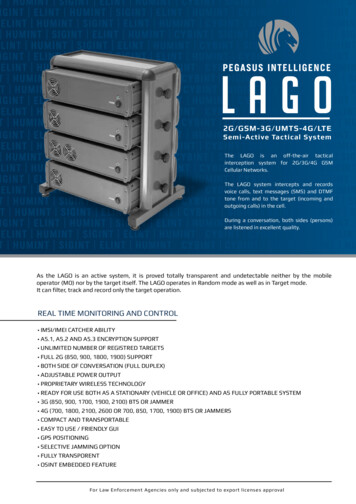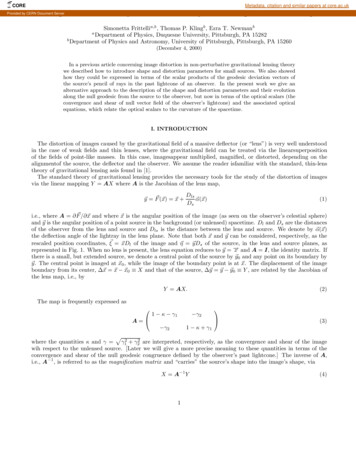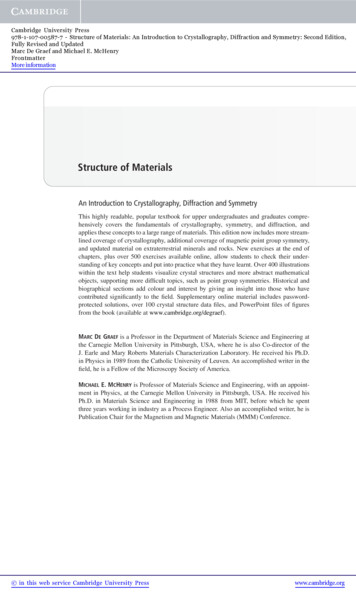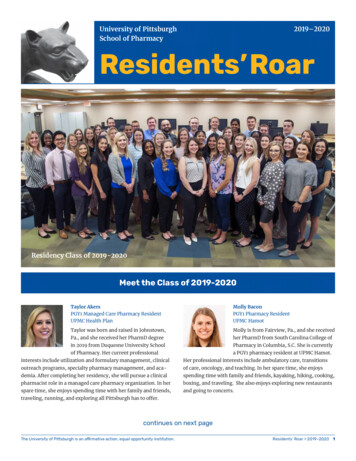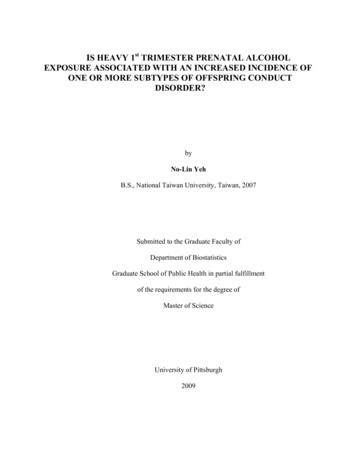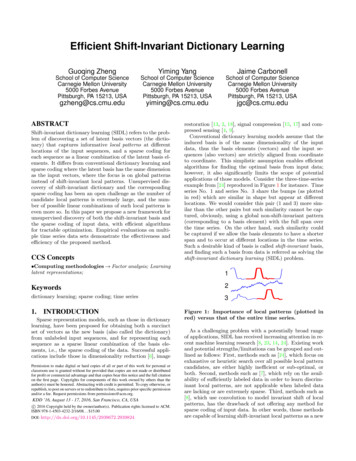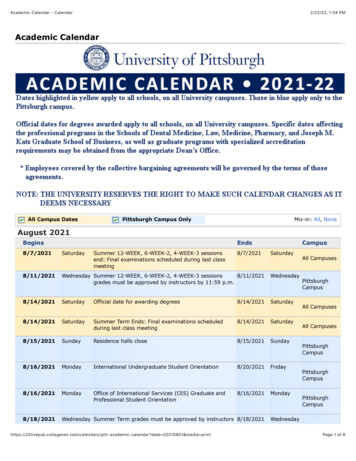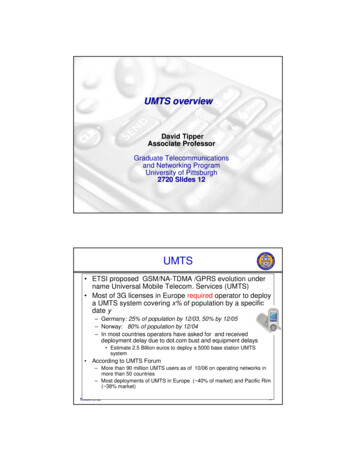
Transcription
UMTS overviewDavid TipperAssociate ProfessorGraduate Telecommunicationsand Networking ProgramUniversity of Pittsburgh2720 Slides 12UMTS ETSI proposed GSM/NA-TDMA /GPRS evolution undername Universal Mobile Telecom. Services (UMTS) Most of 3G licenses in Europe required operator to deploya UMTS system covering x% of population by a specificdate y– Germany: 25% of population by 12/03, 50% by 12/05– Norway: 80% of population by 12/04– In most countries operators have asked for and receiveddeployment delay due to dot.com bust and equipment delays Estimate 2.5 Billion euros to deploy a 5000 base station UMTSsystem According to UMTS Forum– More than 90 million UMTS users as of 10/06 on operating networks inmore than 50 countries– Most deployments of UMTS in Europe ( 40% of market) and Pacific Rim( 38% market)Telcom 27202
UMTS UMTS is a complete system architecture– As in GSM emphasis on standardized interfaces mix and match equipment from various vendors– Simple evolution from GPRS – allows one toreuse/upgrade some of the GPRS backhaulequipment– Backward compatible handsets and signaling tosupport intermode and intersystem handoffs Intermode; TDD to FDD, FDD to TDD Intersystem: UMTS to GSM or UMTS to GPRS– UMTS supports a variety of user data rates and bothpacket and circuit switched services– System composed of three main subsystems3Telcom 2720UMTS System ArchitectureNode BMSC/VLRGMSCPSTNRNCUSIMNode BHLRMEInternetNode BRNCSGSNGGSNNode BUE Telcom 2720UTRANCNExternalNetworksUE (User Equipment) that interfaces with the userUTRAN (UMTS Terrestrial Radio Access Network) handles all radiorelated functionality – WCDMA is radio interface standard here.CN (Core Network) is responsible for transport functions such asswitching and routing calls and data, tracking users4
UMTS System Architecture UE– ME (Mobile Equipment) is the single or multimode terminal used for radiocommunication– USIM (UMTS Subscriber Identity Module) is a smart card that holds the subscriber identity, subscribedservices, authentication and encryption keys UTRAN– Node B (equivalent to BTS in GSM/GPRS) performs the air interface processing (channel coding, rateadaptation, spreading, synchronization, power control). Can operate a group of antennas/radios– RNC (Radio Network Controller) (equivalent to GSM BSC) Responsible for radio resource management and control of theNode Bs. Handoff decisions, congestion control, power control,encryption, admission control, protocol conversion, etc.5Telcom 2720UTRAN architectureRNSUE1Node BIubRNCRNC: Radio Network ControllerRNS: Radio Network SubsystemCNUE2Node BUE3IurNode BIubNode BRNCNode B UTRAN contains severalRNSs Node B can support FDDor TDD or bothIu RNC is responsible forhandover decisionsrequiring signalingto theUE Cell offers FDD or TDDRNSTelcom 27206
UMTS System Architecture Core Networks (CN)– HLR (Home Location Register) database located in the user’s home system that stores the master copy of theuser’s service profile. The HLR also stores the UE location on the level ofMSC and SGSN,– 3G MSC / VLR Switch and database that serves the UE in its current location for CircuitSwitched (CS) services. The MSC function is used to switch the CStransactions, and VLR function holds a copy of the visiting user’s serviceprofile, as well as more precise information on the UE’s location within theserving system.– 3G GMSC (Gateway MSC) Switch at the point where UMTS is connected to external CS networks. Allincoming and outgoing CS connections go through GMSC.– 3G SGSN (Serving GPRS Support Node) Similar to that of MSC / VLR but is used for Packet Switched (PS) services.The part of the network that is accessed via the SGSN is often referred to asthe PS domain. Upgrade version of serving GPRS support node.– 3G GGSN (Gateway GPRS Support Node) Functionality is close to that of GMSC but is in the relation to PS services.Upgraded version of gateway GPRS support Node7Telcom 2720Core network The Core Network (CN) and the Interface Iu areseparated into two logical domains: Circuit Switched Domain (CSD)––––Circuit switched service including signalingResource reservation at connection setup3G versions of GSM components (MSC, GMSC, VLR, HLR)IuCS Packet Switched Domain (PSD)– Handles all packet data services– 3G versions of GPRS components (SGSN, GGSN)– IuPS General approach of building on GSM/GPRSinfrastructure ,helps to saves and faster deploymentTelcom 27209
Core network: uCSAuCEIRHLRGRNode BIubNode BRNCSGSNGGSNGnNode BIuPSRNSGiCN10Telcom 2720GSM Æ GPRS gisterBaseStationControllerdataPCUTelcom 2720SGSNGGSN11
GSM Æ GPRS Æ UMTS llerdata3GSGSN3GGGSN12Telcom 2720WCDMA Wideband Code Division Multiple Access (WCDMA)– The air radio interface standard for UMTS– Wideband direct sequence spread spectrum– Variable orthogonal spreading for multiple access (OVSF) Three types of interface :– FDD: separate uplink/downlink frequency bands withconstant frequency offset between them– TDD: uplink/downlink in same band but time-sharestransmissions in each direction– Dual mode :supports FDD and TDD Wide range of data rates due to CDMA with variablespreading, coding and modes– Varying user bit rate is mapped to variable power and spreading– Different services can be mixed on a single carrier for a userTelcom 272013
WCDMA 5-MHz Channel (25 GSM channels)– Each service provider can deploy multiple 5MHzcarriers at same cell site– Each 5 MHz shared by multiple subscribers usingCDMA– Maximum chip rate 3.84 Mchips/sec Standard advantages of CDMA––––Soft handoffFrequency reuse cluster size of 1,Better quality in multipath environmentRAKE receiver QPSK modulation14Telcom 2720Scrambling and Channelization Channelization codes are orthogonal codes– Separates transmissions from the same source– Uplink: used to separate different physical channelsfrom the same UE – voice and data session– Downlink: used to separate transmissions to differentphysical channels and different UEs– UMTS uses orthogonal variable spreading codes Scrambling (pseudonoise scrambling)– Applied on top of channelization spreading– Separates transmissions from different sources– Uplink effect: separate mobiles from each other– Downlink effect: separate base stations from eachotherTelcom 272015
Physical Layer: Spreading Spreading of the low-bandwidth data signal toproduce the wideband CDMA signal consists oftwo steps:– Channelization or spreading code to reach channel rateof 3.84 Mchips/s– Scrambling – to provide separation of transmissions16Telcom 2720Channelization SpreadingUMTS uses variable spreading and power levels to provide different user datarates. In FDD mode 10 msec frames are usedThe number of chips per bits is called the Spreading Factor (SF) and definethe data service required for the user:Tbit SF x TchipFor UMTS:Bit Rate x SF 3.84 Mchips/s (Chip Rate)SF can change in every 10 msec frameServiceBearer Date Rate (kbps)SFModulation Rate (Mchips/s)Speech301283.84Packet 64 kbps120323.84Packet 384 kbps96043.84Telcom 272017
WCDMA Variable SpreadingThe channelization codes are Orthogonal Variable Spreading Factor codesthat preserves the orthogonality between a user’s different physical channels.The OVSF codes can be defined using a code tree.In the code tree the channelization codes are uniquely described as CCH,SF,kwhere SF is the Spreading Factor of the code and k is the code number,0 k SF – 1CCH,4,0 1 1 1 1CCH,2,0 1 1CCH,4,1 1 1 –1 –1CCH,1,0 1CCH,4,2 1 –1 1 –1CCH,2,1 1 –1CCH,4,3 1 –1 –1 1SF 1SF – 2SF 4SF between 4 and 512 on DLbetween 4 and 256 on UL19Telcom 2720Scrambling and Channelization CodesChannelization codeUsageLengthNumber ofcodesCode familySpreadingTelcom 2720Scrambling codeUplink: Separation of physicaldata and control channels fromsame terminalUplink: Separation ofterminalsDownlink: Separation of downlinkconnections of different userswithin one cellDownlink: Separation ofsectors (cells)4-256 chips (1.0-66.7 μs)Downlink also 512 chipsUplink: 10 ms 38400 chipsor 66.7 μs 256 chipsDownlink: 10 ms 38400chipsNumber of codes under onescrambling code spreadingfactorUplink: Several millionsDownlink: 512Orthogonal Variable SpreadingFactor (OVSF)Yes, increases transmissionbandwidthLong: Gold codeShort: Extended S(2)familyNo, it does not affecttransmission bandwidth20
WCDMA QPSK Modulator21Telcom 2720Turbocodes Used in 3G cellular (UMTS) standard TurboCode: Concatenation of codeswith interleaving - followed by aniterative algorithm for decoding Use soft decisions to make thedecoding powerful. Instead of counting differences in bitpositions, distance probabilities areused.Telcom 272022
Concatenated Code SystemDataInner CodeEncoderR K/N coder k/nModulatorOverall Code rate RrConcatenation makes coding more powerfulTurbocodes adds an interleaving stepSourceDecoderInner CodeDecoderRadio ChannelOuter CodeEncoderDemod-ulator23Telcom 2720WCDMA Forward Error Control Convolutional Coding:for voice and control info– ½ rate and 1/3 ratecodes with constraintlength 8 Block Interleave over 10,20, 40, or 80 ms Turbo Coding for dataand some control info– Two parallel rate 1/3convolutional codesconstraint length 3 withinterleaving – blocklength 320 – 5120 bits– Iterative decoding toimprove BER in poorchannel environments.Telcom 272026
Turbocode Performance27Telcom 2720WCDMA ParametersChannel bandwidth5.MHzDownlink RF channelstructureDirect spread spectrumQPSK modulationChip rate3.84 McpsFrame length10ms/20ms (optional TDDmode)HandoverSofter handover, softhandover and interfrequencyhandoverTelcom 272028
UMTS FDD frame structureRadio frame10 ms012.121314Time slot666.7 µsPilotTFCIFBITPCuplink DPCCH2560 chips, 10 bits666.7 µsuplink DPDCHData2560 chips, 10*2k bits (k 0.6)666.7 µsData1 TPC TFCI Data2Pilotdownlink DPCHDPDCH DPCCH DPDCH DPCCH2560 chips, 10*2k bits (k 0.7)Slot structure NOT for user separationbut synchronisation for periodic functions!FBI: Feedback InformationTPC: Transmit Power ControlTFCI: Transport Format Combination IndicatorDPCCH: Dedicated Physical Control ChannelDPDCH: Dedicated Physical Data ChannelDPCH: Dedicated Physical Channel29Telcom 2720UMTS Data rate adjusted every 10 msec by variable spreading and powerTelcom 272030
UMTS Protocol Stack– User Plane Radio Link Control (RLC)– Presents a reliable channel to higher layers by retransmitting erroneouspackets Medium Access Control (MAC)– Channel access, multiplexing traffic streams, scheduling priority flows Physical Layer– Measurements, power control algorithms– Control Plane Radio Resource Control (RRC)– Connection and QoS management Radio Resource Management (RRM)– Algorithms for admission control, handovers32Telcom 2720UMTS protocol stacks (user plane)CircuitSwitchedDomainUses same protocols as GSMUEPacketSwitchedDomainBuilds onGPRSStackTelcom 2720apps. &protocolsIP, PPP, PDCPRRM/RLCUuUTRANIuPS3GSGSNIP tunnelPDCPGTPRRM/RLC UDP/IPGTPUDP/IP UDP/IPGTPGn3GGGSNIP, PPP, GTPUDP/IPMACMACAAL5AAL5L2L2radioradioATMATML1L134
RLC Functions Segmentation and reassemblyConcatenationPaddingTransfer of user dataError correctionIn-sequence deliveryDuplicate detectionFlow controlSequence number check (UM)Protocol error detection and recoveryCipheringSuspend/resume function for data transfer35Telcom 2720Air Interface/Physical Layer Radio interface protocol architecture aroundthe physical layerLayer 3Layer 1Telcom 2720Control / MeasurementsLayer 2Radio Resource Control (RRC)Logical channelsMediumAccessControlTransport channelsPhysical layer36
MAC ArchitecturePCCH BCCH CCCH CTCH SHCCHBCCH( TDD only )MAC Control DCCH DTCHDTCHMAC-dMAC-c/shMAC-bPCHFACH FACH RACH CPCH USCH USCH DSCH DSCHDCHDCH( FDD only ) ( TDD only ) ( TDD only )37Telcom 2720MAC Functions Mapping of logical channels onto transport channelsSelection of transport format for each transport channelPriority handling between data flows of one MSPriority handling between MSs by means of dynamicschedulingIdentification of MSs on common transport channelsMultiplexing/demultiplexing of higher layer PDUs into/fromtransport blocks to/from the physical layerTraffic volume monitoringDynamic transport channel type switchingCiphering Access service class selection for RACH transmissionsTelcom 272038
MAC: Logical Channels Control channels:– Broadcast control channel (BCCH)– Paging control channel (PCCH)– Dedicated control channel (DCCH)– Common control channel (CCCH) Traffic channels:– Dedicated traffic channel (DTCH)– Common traffic channel (CTCH)39Telcom 2720MAC Entities MAC-b handles the following transport channels:– broadcast channel (BCH) MAC-c/sh handles the following transport channels:––––paging channel (PCH)forward access channel (FACH)random access channel (RACH)common packet channel (UL CPCH). The CPCH exists only inFDD mode.– downlink shared channel (DSCH) MAC-d handles the following transport channels:– dedicated transport channels (DCH)Telcom 272040
MAC: Mapping Between LogicalChannels and Transport Channels41Telcom 2720Physical Channels Primary Common Control Physical Channel (PCCPCH)Secondary Common Control Physical Channel (SCCPCH)Physical Random Access Channel (PRACH)Dedicated Physical Data Channel (DPDCH)Physical Downlink Shared Channel (PDSCH)Physical Common Packet Channel (PCPCH)Synchronization Channel (SCH)Common Pilot Channel (CPICH)Acquisition Indicator Channel (AICH)Paging Indication Channel (PICH)CPCH Status Indication Channel (CSICH)Collision Detection/Channel Assignment Indicator Channel (CD/CAICH)Telcom 272042
Physical Channels –Physical Random Access Channel (PRACH)43Telcom 2720Physical Channels –Dedicated Uplink Physical ChannelTelcom 272044
Physical Channels –Physical Common Packet Channel (PCPCH)P1PjPjMessage PartP04096 chips0 or 8 slotsN*10 msecAccess PreambleControl PartCollision DetectionPreambleData part45Telcom 2720UTRAN Procedures Fast closed-loop power controlOpen-loop power controlPagingRandom-access channel procedureCPCH operationCell searchTransmit diversityHandover measurementsSoft HandoffTelcom 272046
UMTS Architecture: Control PlaneGMM /SM / SMSGMM /SM / -PsRNS3G SGSN[2]47Telcom 2720RRC: Functions and SignalingProcedures Broadcast of information related to the non-accessstratum (Core Network) Broadcast of information related to the access stratum Establishment, maintenance and release of an RRCconnection between the UE and UTRAN Establishment, reconfiguration and release of RadioBearers Assignment, reconfiguration and release of radioresources for the RRC connection RRC connection mobility functions Control of requested QoSTelcom 272048
RRC: Functions and SignalingProcedures (cont.) UE measurement reporting and control of thereporting Outer loop power control Control of ciphering Slow DCA (TDD mode) Paging Initial cell selection and cell re-selection Arbitration of radio resources on uplink DCH Timing advance (TDD mode) CBS control.49Telcom 2720UMTS Diversity UMTS – DS- CDMA support multi-path diversity– Note can tolerate a wider range of multi-path delay spread than IS-95due to greater spreading UMTS supports macro-diversity.– Allows UE to transmit the same signal via 2 or more cells, in order tocounteract interference problems. When macro-diversity is used, and when 2 cells are belonging to 2Node Bs, that are belonging to 2 different RNCs, these RNCs havea specific functionality:– Serving RNC (SRNC): a role a RNC can take with respect to a specificconnection between a UE and UTRAN. There is one SRNC for each UEthat has a connection to UTRAN. The SRNC is in charge of the radioconnection between the UE and UTRAN.– Drift RNC (DRNC): a role a RNC can take with respect to a specificconnection between a UE and UTRAN. A RNC, that supports the SRNCwith radio resources when the connection between the UTRAN and theUE needs to use cell(s) controlled by this RNC, is referred to a DriftRNC.Telcom 272050
Power ControlIn order to maximize the cell capacity, it has to equalize the receivedpower per bit of all mobile stations at all times.Open loop power controlThe initial power control is Open Loop. The MS (UE) estimates thepower level based on the received level of the pilot from the BTS(Node B). If no response is received the MS waits a defined time andretransmits with a higher power level. The MS continues to do this untilit receives a response.MS Access 1 with estimated powerMS Access 2 with increased power.MS (UE)MS Access n with increased powerBTS (Node B)Response with power control51Telcom 2720Power ControlClosed loop power controlWhen communication is established, power is controlled by theClosed Loop Power Control.RNC sets SIR target for serviceBTS sends power control bitsTo MS (UE) (1500 times/sec)MS transmits (Tx)RNC calculates BLER for TxMS (UE)BTS (Node B)RNC sends new SIR targetRNCContinues poser controlInner LoopOuter LoopTelcom 272052
Power Control The RNC sets the target BLER (Block Error Rate) level for the service.– RNC derives SIR (Signal to Interference Ratio) target from BLER, andsends it to the BTS. Uplink RNC performs frequent estimations of the received SIR andcompares it to a target SIR.––––If measured SIR is higher than the target SIR,the base station will command the MS to lower the power:If it is too low, it will command the mobile station to increase its power:The measured-command-react cycle is executed a rate of 1500 times persecond (1.5 KHz) for each mobile station (Inner Loop). The RNC calculates the SIR target once every 10 ms (or moredepending on services) and adjusts the SIR target (Outer Loop). Downlink, same closed-loop power control technique is used but themotivation is different: it is desirable to provide a marginal amount ofadditional power to mobile stations at the cell edge, as they sufferincreased adjacent cell interference.53Telcom 2720QoS Classes/ServicesTraffic classCharacteristicsApplicationexamplesTelcom 2720ConversationalPreserve timerelation(variation)betweeninformationentities of thestreamConversationalpattern(stringent andlow icationsMore tolerantto jitter thanconversationalclass. Use ofbuffer tosmooth outjitterRequestresponsepatternPreservedata integrityDestination isnot expectingthe data withina certain timePreserve nload of email, electronicpostcardVoice, videoStreamingtelephony, video multimediagames54
Conversational ClassesSpeech service Speech codec in UMTS employs a Adaptive Multi-rate (AMR)technique. The multi-rate speech coder is a single integratedspeech codec with eight source rates: 12.2 (GSM-EFR), 10.2,7.95, 7.40, 6.70, 5.90, 5.15, 4.75 kbps and 0 kbps. The AMR bit rates are controlled by the radio access networkand not depend on the speech activity. For interoperability with existing cellular networks, some modesare the same as in existing cellular networks:12.2 kbps GSM EFR codec7.4 kbps North American TDMA speech codec6.7 kbps Japanese PDC The AMR speech coder is capable of switching its rate every 20ms speech frame upon command.55Telcom 2720Admission Control Accepts or rejects requests to establish a radio access bearer Located at the RNC Estimates the load increase that the establishment of the radioaccess bearer would cause to the radio network Check is applied separately for uplink and downlink directions Radio access bearer will be accepted if admission control admitsboth uplink and downlink Example:Widebandpower-basedadmission controlTelcom 272056
Handover in UMTS1Comm. TowerNode BComm. TowerComm. TowerComm. Tower2Comm. TowerSoft handoffWhen stay onsame frequencyin adjacentsectors or cellsNode BComm. Tower3Comm. TowerComm. Toweriu4BTSRNSCore Network57Telcom 2720Types of UMTS Handoffs1.2.3.4.Intra RNC: between Node B’s or sector of same NodeB’s attached to same RNCInter RNC: between Node B’s attached to differentRNC’s, can be rerouted between RNC’s locally if link ,or rerouted by 3GMSC/SGSN, if RNC’s in same serviceareaInter 3GMSC/SGSN between Node B’s attached todifferentInter System Handoff – between Node B and BTS alongwith a change of mode (WCDMA, GSM), (WCDMA,GPRS)Note types 1,2, and 3 can be a Soft/Softer or Hard handoff,whereas, type 4 is always a Hard handoffTelcom 272058
UMTS Intersystem Handoff Hard Handover– If the UE is obliged to hand over to a different frequency (on another systemlike GSM or GPRS, or not), this is know as a hard handover.2. Prepare HO requestUMSCMSC5. Prepare HO response6. IAM1. Relocation required3. HO request7. ACM4. HO request ACK8. Relocation commandBSSServingRNC3. Allocate radio resources9. HO command1. Decision to perform HO to GSMIAM: Initial Address MessageACM: Address Complete MessageUEUMTS to GSM Handover59Telcom 2720UMTS Intersystem Handoff11. Process access signaling requestUMSCMSC12. ANIM15. SEND END signal request16. Release command14. HO complete17. Release complete10. HO detectBSSServingRNC10. HO Access13. HO completeUEUMTS to GSM Handover continuedTelcom 272060
Location ManagementThree types of location updating1. Location Area (LA)- zone registration as in GSM, plus can requireperiodic registration of users2. Routing Areas (RA) – zone registration as in GPRS for packetbased services3. UTRAN Registration Areas (URA) – zone registration for certaintypes of services63Telcom 2720UMTS Security UMTSSecurity Functions Main security elements from GSM Authentication of subscribers using challenge/response Subscriber identity confidentiality (TMSI) SIM card (call USIM) Authentication of user to USIM by use of a PIN Radio interface encryption UMTS enhancements/new features Mutual authentication to protect against false basestations New encrpytion/key generation/authentication algorithmswith greater security Encryption extended farther back into wired network(prevents eavesdropping on microwave relays)Telcom 272064
UMTS Security Architecture65Telcom 2720UMTS Security UMTS authenticates and encrypts circuit switched and packetswitched connections separately (even from same MS) AUC and USIM have 128 bit shared secret data When authentication requested AUC generates a vector of128 bit integrity keys (IK) using algorithm f4 with a 128 bitrandom number input RAND Authetication challenge is created using algorithm f9 withinputs: Integrity Key Direction of transmission (up or downlink) 32 bit random number: FRESH Hyperframe count (32 bits) – prevents replay attacks Only RAND and FRESH and the correct response aretransmitted over the airTelcom 272066
UMTS SecuritySecurity architecture at AUC67Telcom 2720UMTS Security After authentication encryption provided using algorithm f8,with inputs 128 bit cipher key CK, Hyperframe count (32 bits),direction, etc. CK is created by algorithm f3 using 128 bit random numberRAND and 128 bit shared secret data of USIM/AUC The encryption algorithms allow for future improvement User specifies protocol version (algorithm used) in set upmessage along with times for length of using IKs Currently Kasumi algorithm or Advanced EncryptionStandard are used for f8 and f9 May eventually move to using IP level encryption andauthenticationTelcom 272068
UMTS System ArchitectureInternet/ DatanetworksPSTN/ISDNGGSNOther PLMNHLRGGSN3G SGSNVLR3GMSCRNSRNCNode BRNSNode BRadio access networkTelcom 2720The UMTS system architecture69HIGH SPEED DOWLINK PACKET ACCESS (HSDPA) HSDPA 3.5G system upgrade of UMTS Standardised in 3GPP Release 5 Objective is to support delay-tolerant services in lowmobility scenarios with with enhanced resourceefficiency and service quality– support for background, interactive and (to some extent)streaming services– low mobility– enable downlink peak rates of 8-10 Mbits/s 3G requirements– lower resource consumption per transferred delay-tolerant bitTelcom 272070
HIGH SPEED DOWLINK PACKET ACCESS HSDPA upgrade of UMTS similar to EDGE upgrade ofGPRS– completely backwards compatible– no new spectrum needed– reuse existing infrastructure and 5MHz channels primarily software and minor hardware upgrades– coexistence of HSDPA- and non-HSDPA-enabled terminals– coexistence of HSDPA- and non-HSDPA-enabled NODE-Bs data flows on HS-DSCH moving from non-HSDPA-cell to HSDPAcellare automatically switched to a supported transport channel, e.g.DCH gradual hot-spot-based network upgrades possible– cost-effective71Telcom 2720HSDPA ArchitectureUEchannel qualityindicatorNODEBRNCsharedchannel Upgrade UMTS downlink channels to a HS version:–higher-order modulation: QPSK and 16-QAM–fast link adaptation: adaptive modulation and coding–fast channel-aware scheduling: centered at the Node B–fast hybrid ARQ on downlink: combines FEC and selective ARQ–reduced TTI of 2 ms: to facilitate better tracking of channel variations– HS channels typically transmits at relatively fixed powerTelcom 272072
NEW PHYSICAL CHANNELS PHYSICAL k SF 16downlinkuplinkSF 256data only (up to 15 streams to a user)MAC-hs signalling, H-ARQ,etc.CQI, (N)ACKHCCDPHSCHDPHSCPDHSCHDPHsCCSHS73Telcom 2720HSPDA vs. UMTSTelcom 272074
PHYSICAL LAYER PROCESSING Physical Layer Processinginformationbit sequenceTurbo encodingCRCmodulation(series parallel)rate matchingmapping oncode lationotherchannelsADAPTIVE75Telcom 2720ADAPTIVEMODULATION AND CODING LINK ADAPTATION: channel-dependent AMC typically more efficient for services that tolerate short-term data rate variations with only power-controlled channels, it is difficult to exploit all resoures AMC can exploit resources better, at the cost of transfer rate jitter Fixed spreading factor SF but variable number of streams and bits per channel symbolMODULATIONQPSKSPREADINGFACTORTURBOCODE RATEBITS/BLOCK/CODEDATA RATE(15 CODES)161/42401.8 Mbps161/24703.6 Mbps163/47115.3 Mbps161/29507.2 Mbps163/4144010.8 Mbps16-QAMTelcom 272076
PACKET SCHEDULING SCHEMES Round robinfairness– serve data flows cyclically SNR-basedefficiency2 msschedulingSNR– serve data flow with highest CQI Proportional fair scheduler– serve data flow with highest R(t ) / R (t ) ,with R(t ) the instantaneous rate andthe smoothed (α) assigned rate timeSNR Priority reduction scheduler– serve data flow with highest α N (t ) R(t ) , SNRwith α the priority reduction parameter,and N(t) the number of times scheduledtimetime77Telcom 2720HSDPA Upgrades Infrastructure– NODE-B a new MAC sublayer (MAC-hs) is standardised and needsto be implemented in the NODE-B depending on the legacy NODE-B capabilities, this updatemay be done via remote software downloads or maypossibly require hardware upgrades as well– RNC is largely maintains the UMTS Release ’99 functionality a software-only upgrade is required, e.g. to enable assignment ofdata flows to the HS-DSCH ( channel switching)– no substantial impact on the CORE network is expected– New Mobile Terminals Support physical interface, higher data rates and H-ARQ HSDPA deployments began 2006 in Europe,Canada, etc. Over 100 deploymentsTelcom 272078
HSUPA High Speed Uplink Packet Access Similar to HSDPA – advanced coding andmodulation techniques with hybrid ARQ toimprove data rate on uplink channel in UMTS Now called Enhanced Uplink (EUL) (3GPP) Data rates from .73Mbps – 5.76Mbps, 11.5Mbpsbeing tested Uses new Enhanced versions of Signalling andphysical channels Focus of UMTS now on IP in the backhaul79Telcom 27203GPP IP Reference ArchitectureLegacy (2G)mobile networksApplications& servicesPSTNCSCFGatewayHSSHLROther 3GPPPLMNPSTNgatewayGGSNGGSNSGSNInternet/ IPnetworksRNSRNSRNCNode BNode BRadio access networkThe 3GPP IP reference architecture – all traffic IP - with QoS ClassesTelcom 272080
UMTS UMTS is most popular 3G technology– Upgrade path from GPRS/EDGE – primarilyin air interface to WCDMA standard– WCDMA – variable power/spreading cdma– Provides standard benefits of cdmatechnology (frequency reuse factor 1, softhandoff, etc.)– Still in deployment stage in many places– Upgrade path to HSPDA and all IP definedTelcom 272081
scrambling code spreading factor Number of codes Uplink: 10 ms 38400 chips or 66.7 μs 256 chips Downlink: 10 ms 38400 chips 4-256 chips (1.0-66.7 μs) Downlink also 512 chips Length Uplink: Separation of terminals Uplink: Separation of physical data and control channels from same terminal Usage Channelization code Scrambling code
